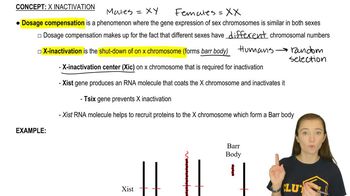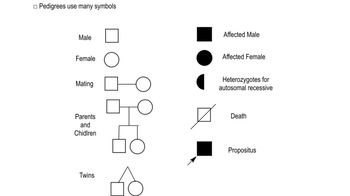Table of contents
- 1. Introduction to Genetics51m
- 2. Mendel's Laws of Inheritance3h 37m
- 3. Extensions to Mendelian Inheritance2h 41m
- 4. Genetic Mapping and Linkage2h 28m
- 5. Genetics of Bacteria and Viruses1h 21m
- 6. Chromosomal Variation1h 48m
- 7. DNA and Chromosome Structure56m
- 8. DNA Replication1h 10m
- 9. Mitosis and Meiosis1h 34m
- 10. Transcription1h 0m
- 11. Translation58m
- 12. Gene Regulation in Prokaryotes1h 19m
- 13. Gene Regulation in Eukaryotes44m
- 14. Genetic Control of Development44m
- 15. Genomes and Genomics1h 50m
- 16. Transposable Elements47m
- 17. Mutation, Repair, and Recombination1h 6m
- 18. Molecular Genetic Tools19m
- 19. Cancer Genetics29m
- 20. Quantitative Genetics1h 26m
- 21. Population Genetics50m
- 22. Evolutionary Genetics29m
2. Mendel's Laws of Inheritance
Pedigrees
Problem 21a
Textbook Question
Use the blank pedigrees provided to depict transmission of (a) an X-linked recessive trait and (b) an X-linked dominant trait, by filling in circles and squares to represent individuals with the trait of interest. Give genotypes for each person in each pedigree. Carefully design each transmission pattern so that pedigree (a) cannot be confused with autosomal recessive transmission and pedigree (b) cannot be confused with autosomal dominant transmission. Identify the transmission events that eliminate the possibility of autosomal transmission for each pedigree.
 Verified step by step guidance
Verified step by step guidance1
<insert step 1: Begin by understanding the characteristics of X-linked recessive and X-linked dominant traits. X-linked recessive traits are more common in males, as they have only one X chromosome. Females must have two copies of the recessive allele to express the trait. X-linked dominant traits can affect both males and females, but females are more frequently affected due to having two X chromosomes.>
<insert step 2: For the X-linked recessive trait (pedigree a), start by identifying a male with the trait. Since males have only one X chromosome, they will express the trait if they inherit the recessive allele. Indicate this by shading the square representing the male.>
<insert step 3: In the same pedigree, ensure that a female carrier (heterozygous) is present. She will have one normal allele and one recessive allele. Indicate this by shading half of the circle representing the female. This female can pass the recessive allele to her sons, who will express the trait.>
<insert step 4: For the X-linked dominant trait (pedigree b), identify a female with the trait. Since females have two X chromosomes, they can express the trait if they have at least one dominant allele. Indicate this by shading the circle representing the female.>
<insert step 5: In the same pedigree, ensure that a male with the trait is present. Since males have only one X chromosome, they will express the trait if they inherit the dominant allele. Indicate this by shading the square representing the male. This male can pass the dominant allele to all his daughters, who will express the trait, but not to his sons.>
Recommended similar problem, with video answer:
 Verified Solution
Verified SolutionThis video solution was recommended by our tutors as helpful for the problem above
Video duration:
3mPlay a video:
Was this helpful?
Key Concepts
Here are the essential concepts you must grasp in order to answer the question correctly.
X-linked Inheritance
X-linked inheritance refers to the pattern of genetic transmission of traits located on the X chromosome. In X-linked recessive traits, males (XY) are more likely to express the trait since they have only one X chromosome, while females (XX) can be carriers if they have one affected X. In contrast, X-linked dominant traits can affect both males and females, but males often exhibit more severe symptoms due to their single X chromosome.
Recommended video:
Guided course

X-Inactivation
Pedigree Analysis
Pedigree analysis is a method used to trace the inheritance patterns of traits through generations in a family tree format. Circles represent females and squares represent males, with filled shapes indicating individuals expressing the trait. This visual representation helps identify whether a trait is autosomal or X-linked by observing the distribution of the trait among genders and generations.
Recommended video:
Guided course

Pedigree Flowchart
Distinguishing Autosomal from X-linked Traits
To distinguish between autosomal and X-linked traits in pedigrees, one must observe the pattern of inheritance. Autosomal recessive traits typically skip generations and can affect both genders equally, while X-linked recessive traits often show a male bias and do not pass from father to son. X-linked dominant traits, on the other hand, appear in every generation and affect both genders, but affected males cannot pass the trait to their sons, which is a key distinguishing feature.
Recommended video:
Guided course

X-Inactivation

 2:48m
2:48mWatch next
Master Pedigree Symbols with a bite sized video explanation from Kylia Goodner
Start learning



